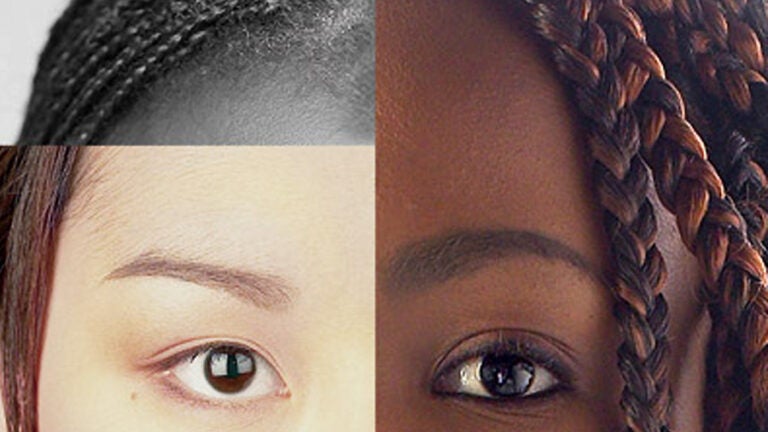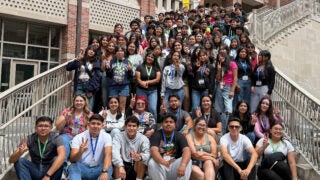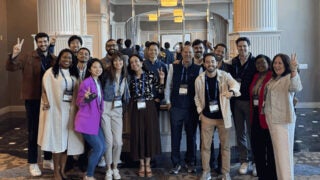
The Critical Media Project catalogues more than 250 popular media examples.
Critical thinking on the media’s messages
USC Annenberg project examines the social implications of the way people are portrayed in pop culture
Students watched in rapt disbelief as a video clip played in class.
“The transformation is frightening. My skin’s really dark, and I’ve always wondered what I’d look like as a different race. In the end, it all came together, and I feel like I looked really exotic.”
We wanted to provide [teachers] with the actual media that could be put in the context of their own curriculum.
Alison Trope
A contestant on The CW show America’s Next Top Model was describing her “transformation” from a white American woman into what was supposed to be a half Japanese, half Malagasy (from Madagascar) woman for the episode’s racial-mixing modeling challenge.
Assigned to be transformed into a Tibetan-Egyptian woman, another white model reflected, “hair and makeup is definitely a long process today … all of us girls have to be painted and plastered with different colors. I mean, it’s going to suck to have to scrub it off later.”
Before the segment ended, several students were already raising their hands. There were so many things wrong with that, they said.
This single clip actively engaged students in critical thinking about topics they’d been discussing for weeks: media representations and the implications for their everyday lives.
- How are different groups portrayed and what does it mean for you?
- How would you articulate a response to problematic representations and advocate for better ones?
- Which messages are so common that they seem “natural?”
- How does this affect your own daily media use?
The questions and discussion prompted by the clip connected theories learned in class to a concrete, relatable pop cultural example.
Access to thought-provoking material
Alison Trope, professor at the USC Annenberg School for Communication and Journalism, uses such media in all her classes, and she wants all teachers to have easy access to similarly engaging, thought-provoking media examples that can help vividly illustrate their lessons.
“If we can understand how our own race, gender, sexuality and class are being represented in the media, it can help us understand how these messages feed into how we live our lives and how we interact with each other,” Trope said. “If we can learn to decode the messages, we can be better equipped to dismiss them or challenge what we’re being fed. The more active we are as consumers of media, the better.”
The Critical Media Project, a media literacy website that catalogues more than 250 popular media examples, aims to do just that.
Trope spearheaded the project as a resource for educators who work with teens and young adults in thinking about how media messages shape how we understand ourselves, each other and the world around us.
A central location for extensive clips
Developed over the last two years, the centralized and categorized Web library of class activities and media examples includes a wealth of socially and historically contextualized clips from movies and television shows, print and video advertisements, news articles, online viral videos, music videos and more.
Aligned with Common Core national curriculum standards and the goals of media literacy educator associations, each media artifact comes with a short description and accompanying discussion questions aimed to encourage critical thinking and analysis. The website also features an extensive list of classroom activities and lesson plans that incorporate the media examples, a glossary of key terms, links to related resources and organizations, and a bibliography of academic work that covers topics related to media, culture, education and identity.
“The study of identity, whether we’re talking about gender, race, class or sexuality, is certainly at the forefront of much high school curriculum,” Trope said, “and media plays a key role in helping to shape the way these identities are formed and enacted in society — throughout history, today and into the future.”
Texts and resources for teachers
Different from other media literacy websites, the primary goal of The Critical Media Project is to provide easily accessible media clips and related resources for educators and parents.
“The goal was to create a site that wasn’t about telling teachers how to ‘do’ media literacy,” Trope said. “Rather, we wanted to provide them with the texts and resources — the actual media — that could be put in the context of their own curriculum and further framed by discussion questions designed to elicit critical analysis among their students.”
For Trope and the team behind the project, the inclusion of media and media literacy in curriculum is especially important.
Most young people are no longer simply active consumers of media, but they are also actively creating their own media as well. This includes teenagers and young adults who are at a developmental stage in which guidance on these and related matters — such as crafting online identities, sharing creative work in a networked community, and learning to critically interpret images and information — is paramount, especially as they are gradually gaining life experiences and learning to negotiate and grow comfortable with their online and offline identities.
Trope worked with then-Ph.D. students Garrett Broad and Melissa Loudon to curate the materials gathered by the students. The Critical Media Project website and Facebook page are part of an ongoing project that is continually updated with examples of new and historical media sent in from teachers and educators, students, parents and other contributors. For more information or to make suggestions and contributions, visit Facebook or Twitter or email criticalmediaproject@gmail.com.



